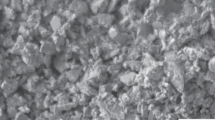Conclusions
We studied the particle distribution of powders of highly coercive multicomponent alloys on the basis of the compound samarium-cobalt as to shape, dimensions, and intensity of magnetization; we examined the dependences of the grain size distribution of the powders on the time of comminution. It was established that the particles have predominantly the shape of parallelepipeds, cubes, tetrahedrons (approximately 30, 20, and 20%, respectively), and that their content depends only very slightly on the time of comminition. The powder contains particles (about 5%) whose vector of magnetization is perpendicular to their major axis; this makes it more difficult to obtain a uniaxial texture and high density of the compacts.
Similar content being viewed by others
Literature cited
S. S. Kiparisov and G. A. Libenson, Powder Metallurgy [in Russian], Metallurgiya, Moscow (1972).
E. G. Povolotskii, Ya. G. Bogatin, L. N. Tul'chinskii, V. V. Nepomnyashchii, “Statistics of powder in connection with morphology and texture formation,” Élektron. Tekh., Seriya 14. Materialy, No. 6, 3–7 (1973).
V. V. Sergeev, V. I. Ermolin, T. I. Bulygina, et al., “The effect of the production processes on the magnetic properties of permanent magnets made of compounds SmCo5,” Élektrotekhnicheskaya Promyshlennost'. Élektrotekh. Mater., No. 2, 14–17 (1972).
B. G. Livshits, A. S. Lileev, V. P. Minushenkov, et al., “Method of determining the perfection of magnetic and crystalline texture in permanent magnets on the basis of SmCo5,” Zavod. Lab.,45, No. 9, 836–839 (1979).
Yu. F. Sapelkina, M. A. Bondarenko, and G. I. Yaglo, “Method of analyzing the dispersity of the magnetic properties of powder particles,” Zavod. Lab.,47, No. 6, 56–58 (1981).
GOST 234002-78. Determination of Particle Size [in Russian], valid since January 1, 1980.
E. I. Pustyl'nik, Statistical Methods of Analyzing and Processing Observations [in Russian], Nauka, Moscow (1968).
V. B. Fedoseev and Yu. F. Sapelkina, Energy of Interaction of Powder Particles of Magnetically Hard Materials [in Russian], Rostov-on-Don (1982). Deposited at VINITI May 13, 1982; No. 2410.
Author information
Authors and Affiliations
Additional information
Translated from Poroshkovaya Metallurgiya, No. 6(294), pp. 42–46, June, 1987.
Rights and permissions
About this article
Cite this article
Sapelkina, Y.F., Yaglo, G.I., Pavlyukov, A.A. et al. Magnetization of powder particles of highly coercive multicomponent samarium-cobalt base alloys. Powder Metall Met Ceram 26, 466–470 (1987). https://doi.org/10.1007/BF00812172
Received:
Issue Date:
DOI: https://doi.org/10.1007/BF00812172




